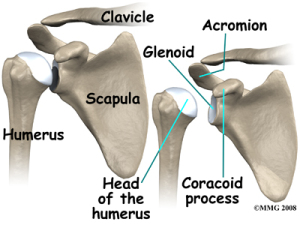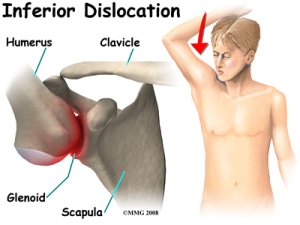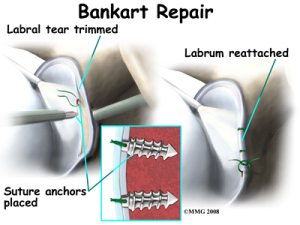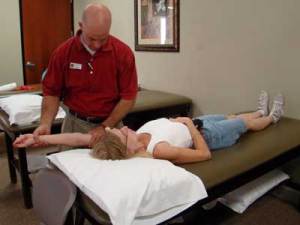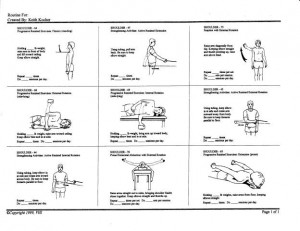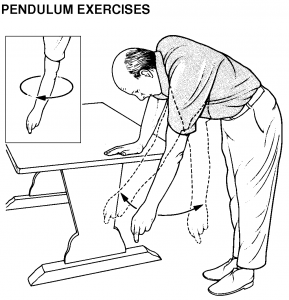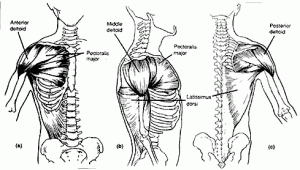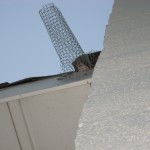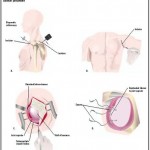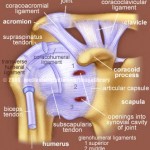As I do every week, I’m following up to last week’s post to document the recovery process as I heal from Open Bankart Shoulder Surgery on my right shoulder. This week has been one of great success and some minor set backs. First the success, by last Friday (11/13/09) I had finally broken through on overcoming my healing plateau. I was finally during my at home PT exercises able to raise my arm during the pendulum forward/back swing above my shoulder (90 degrees) without pain. Later that same day during my PT session my therapist was able to raise my arm in a forward position while laying down to 128 degrees (about what it takes to reach a box of cereal on top of a 6′ tall fridge). I was told this was both significant progress over my prior 120 degree limit and better than normal healing usually allows.
As such, the therapist introduced two new exercises to my at home PT regime: The side to side pendulum swing (5 minutes) and the shoulder shrug (10 reps). This was in addition to my existing 10 forward and backward shoulder rotations, 5 minute forward and backward pendulum swing, 10 forward and backward elbow circles, 10 bicep curls, and 3 repeated 15 second neck to the shoulder stretches on each shoulder. My total work out time climbed from 15 minutes to about 20 minutes per session and believe me– it sounds like a lot less physical work than it really is. Especially when you consider this routine is done three times per day (that’s an hour long work out when you add it up total per day!). Needless to say, the first few times were a bit tiring. I noticed though day over day my endurance and range of motion continued to build.
Then came Tuesday (11/17). The previous day I felt absolutely great. I did light chores around the house (washed dishes, swept, and cooked). I was able to do light routine tasks with my right arm like wash under my left armpit, brush my teeth, shave, and wipe my rear side all without issue. I was also surprised to find out I could with a shuffling motion drive with two hands (I have an automatic V6 Mustang). I was even able to use the mouse for brief periods. In short, I was about about 40% recovered and around where I was about two weeks before surgery. I felt great!
I was doing my afternoon at home PT work out yesterday and was very hopeful about today’s PT visit where I could potentially accomplish some more movement forward in recovery. I was doing my 5 minute forward pendulum swing and my two year old daughter was running around getting into everything. I was busy watching her and not paying enough attention to the swing’s peak position. That’s when in one forward and upward motion I overreached with my swing limit. I ended up going well beyond 128 (I guess it was somewhere around 140). There was a brief sharp sting through my arm much like the kind you get when you get an electric shock from an outlet. I could continue on with the PT session, but my range of motion was noticeably reduced.
That entire evening I felt very sore, but not in any significant pain. I had no trouble sleeping, but this morning when I woke up I was more stiff on my right body than I had been for the past two plus weeks. I knew since I could raise my arm I hadn’t torn anything. This was discomfort and soreness like too hard a work out at the gym and waking up the next day to regret it. It was not shoulder dislocation grade pain though. It was clear I had over extended my arm and probably strained my bicep in the course of doing so. I spent the rest of the day icing myself and gave myself some heat before bed. I also lightened the work load on my afternoon and evening at home PT routine by reducing the pendulum swing range.
When I got to PT today they started by heating my arm. Then an elongated massage. There was noticeable reduction in swelling around my incision scar and bicep itself since my last PT visit. Clearly the inflammation (though bothersome) was not severe. In fact, but all observations the arm was near normal in size. Regardless, any motion above 90 degrees had to be done gingerly because of the lingering soreness. We did manage to get my right arm to 128 degrees so there was no reduction in range (which is good).
More concerning though was something else I hadn’t noticed until the major surgery swelling/pain was able to heal over the course of the last week. I had a bruised like feeling in my humerus’s frontal lobe (that’s the bone in the upper arm). I’d been noticing a lingering pain in the top part of my arm and had simply been treating it with both ice and heat (which helped it somewhat) thinking it was just part of the overall pain. That pain/bruise/whatever had been there since the major soreness of the surgery subsided some three weeks ago. The problem is that except for my pulled bicep; the rest of my arm was now painless except for that humerus lobe region.
The bigger problem is that is the very part of the bone in your arm that must pass through the collarbone/clavicle when going beyond 130 degrees as you reach forward and upward. There was no way that lobe would pass through the bone without a rubbing sensation that was indeed true pain (somewhere around a 6 plus). Therefore the therapist broke off therapy. It was clear that I needed to have that lobe heal before I could move any further. With that we ended the session with ice and therein my disappointment of:
- Pulling my bicep in a random accident that set me back a week easy.
- Finding out though the majority of my arm is healing there is still this abnormal inflammation of the humerus head. Leaving a bigger question of when/how can we make that go away?
I’m continuing, per my therapist, my at home PT exercises though in a slightly less strenuous manner during the pendulum swings. I’m also watching that I don’t go above 120 degrees. I’m continuing to ice the joint as well after each session. This Friday we’ll revisit my range of motion forward/upward from there and hopefully (if my healing pattern holds true) by the following Monday I should be able to get to 130 plus (or at least feel as well as I did yesterday before my accident).
I also had a minor side issue with my insurance provider. For whatever reason they only accepted eight visits to PT instead of the full 16 I need. Eight visits isn’t enough (I’m on visit five as of today’s visit) to let me recover properly. Apparently there is some paperwork the PT can do to show them I need additional treatment. I surely hope so– I cannot afford the non-insurance rates and there’s no way I can stop therapy after next week. I’m not even two weeks in on PT and by all medical professional estimates I’ll need a total of at least six weeks of PT to be able to work out on my own going forward.
My second major post operation milestone is on Monday (11/23). Before my Monday PT, I visit my orthopedist for post op check up number two (week five). He’s going to review my PT results and decide from there if I can go back to work (12/7 was the six week post op target) full time, as well as, what’s best to move me along to final healing in PT. I’m hoping for good news. My FMLA and disability goes out into the first week of January 2010 (12 weeks total), but I really want to get back to work. Sitting around the house and doing nothing is driving me crazy. The flip side is that if I’m not physically in a place where I can return to work I’ll be of no value to them.
This is all the more frustrating with today our CEO announcing my promotion to Network Operation Manager. I really am itching to get back to work and get the ball rolling on some projects, but here at I am at home– sore as Hell. Label that frustration number three for the record.
I’ll update next week as per usual to let you know how it all goes. Clearly this is where things get tough and patience needs to become a virtue I learn to respect for my own good. In my heart of hearts, I know that if I don’t let my body heal and recover properly I’ll, in the long term, be physically of no value to anyone (my family, my employer, myself, etc…) and that is something I keep in my mind to balance things out.
Week six seemingly cannot come fast enough.

